Explanatory Notes The 2023 Statistical Handbook on Women and Men in MIMAROPA is a gender statistical resource published by the Philippine Statistics Authority – Regional Statistical Services Office MIMAROPA (PSA RSSO MIMAROPA). The handbook presents the most recent gender-disaggregated data across various sectors, providing a reliable reference for crafting policies and programs that promote gender equality and inclusivity in the MIMAROPA region. This advances gender-responsive planning and policy formulation, which may result to Gender and Development (GAD) initiatives at the subnational level. |
Sex ratio in the MIMAROPA Region stands at 104 males per 100 females
Based on the results of 2020 Census of Population and Housing conducted by the Philippine Statistics Authority, there were 3,228,558 people in the MIMAROPA Region as of 12:01 a.m. of 01 May 2020, of which 48.8 percent were women and the remaining 51.2 percent were men. This translates to a sex ratio of 104 men for every 100 women. (Table 1)
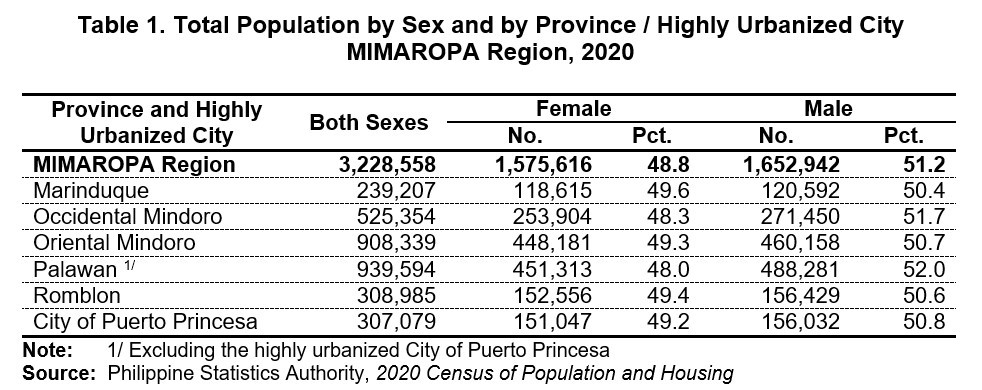
Household population refers to the number of people living together in a housing unit with a common arrangement in the preparation and consumption of food. This excludes people residing in institutional settings like hotels / lodging houses / dormitories, hospital and nurses’ homes, welfare institutions, corrective and penal institutions, convents / nunneries / seminaries / boarding schools, military camps and stations, and public works camps. In the MIMAROPA Region, household population comprised 99.5 percent of the region’s total population, with 3,212,287 people living in households. Of these, 1,573,463 people were female (49.0%) while 1,638,824 people were male (51.0%).
Looking into the age group of MIMAROPA Region’s household population, young people with age below 15 years old, comprised 1,045,884 people or 32.6 percent of the region’s household population. In this age group, young women had a share of 48.2 percent. Similarly, women had a lower proportion from the age group 15 to 59 years old at 48.6 percent. In contrast, female senior citizens posted a greater percentage of 54.5 percent among the region’s household population 60 years old and over. (Figure 1)
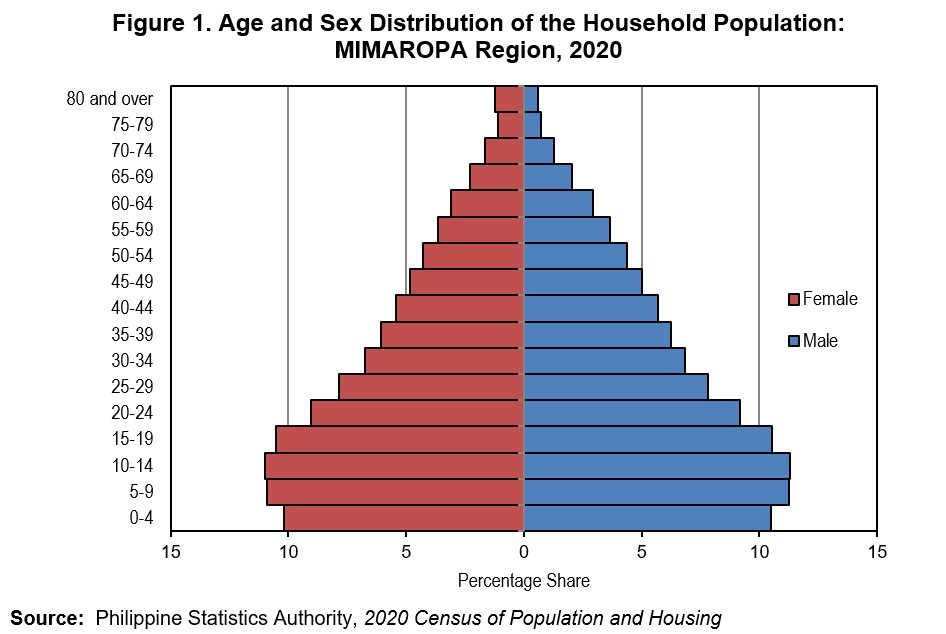
Two in every five persons in the labor force are women
According to the 2022 Annual Labor Force Survey, about 1.38 million MIMAROPAns were in the labor force out of the region’s 2.12 million people 15 years old and over. This translates to 65.4 percent labor force participation rate. (Table 2)

Women had 40.0 percent share to the population 15 years old and over in the labor force with an estimated 554.06 thousand in 2022. Meanwhile an estimated 830.01 thousand men 15 years old and over have been in the labor force in the same year. Consequently, women’s labor force participation rate in 2022 is 53.5 percent, which was 23.3 percentage points lower than men’s labor force participation rate of 76.8 percent. (Table 2)
Women constitutes two in every five employed persons and four in every nine unemployed persons
In terms of the number of employed individuals in the region, women accounted to 39.9 percent of the region’s 1.32 million employed individuals or an estimated 527.02 thousand employed women. This translates to the regional women’s employment rate of 95.1 percent, which was 0.7 percentage point lower than men’s regional employment rate of 95.8 percent. (Table 2)
In contrast, an estimated 27.05 thousand unemployed women accounted 43.8 percent of the region’s total of 61.79 thousand unemployed individuals in 2022. Women’s regional unemployment rate in this year was registered at 4.9 percent, higher by 0.7 percentage point than 4.2 percent of the men’s regional unemployment rate. (Table 2)
Seven out of ten employed professionals are women
Out of the 1.32 million employed individuals in the region, an estimated 417.0 thousand or 31.5 percent were engaged in elementary occupations. Of this, women constituted 35.4 percent while men had a greater representation at 64.6 percent. In contrast, employment was the least in the armed forces occupations with an estimated 1.24 thousand individuals. Women had a small share of 15.3 percent while men had the most of the employment at 84.7 percent. (Figure 2 and Table A)
Occupation groups that are women-dominated include service and sales workers with an estimated 170.58 thousand workers (69.5% share), managers at 41.34 thousand personnel (53.9% share), clerical support workers at 28.54 thousand workers (59.0% share), technician and associate professional at 20.43 thousand workers (52.9% share). (Figure 2 and Table A)
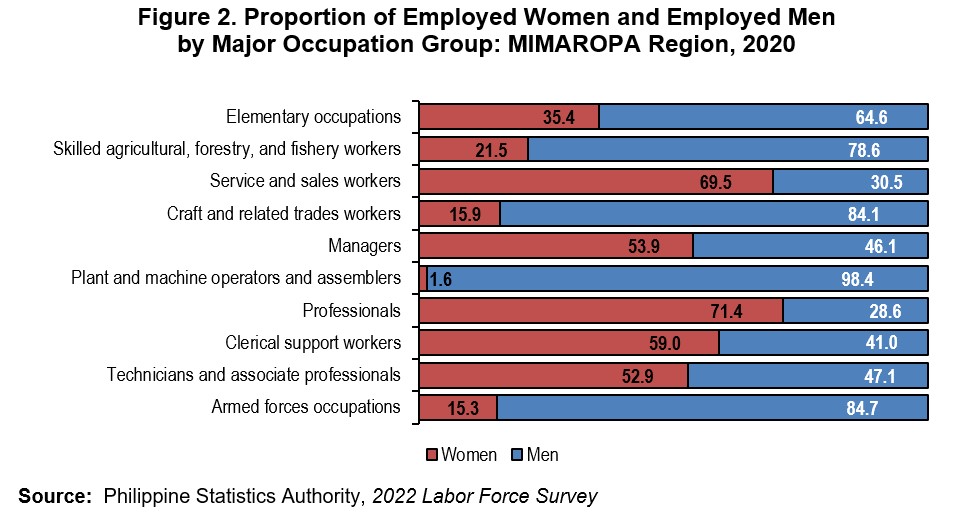
On the other hand, there more male engaged in elementary occupations with an estimated 269.42 thousand workers (64.6% share), skilled agricultural, forestry, and fishery works at 230.85 thousand workers (78.5% share), craft and related trades at 72.03 thousand workers (84.1% share), plant and machine operation and assembly at 57.27 thousand workers (98.4% share) and in armed forces occupations with an estimated 1.05 thousand personnel (84.7% share). (Figure 2 and Table A)
Two in every five beneficiaries of agricultural programs are women
In 2023, the Department of Agriculture (DA) MIMAROPA recorded a total of 82,641 beneficiaries of its agricultural programs. Women represented 38.6 percent, while men were the remaining 61.4 percent. (Table 3)
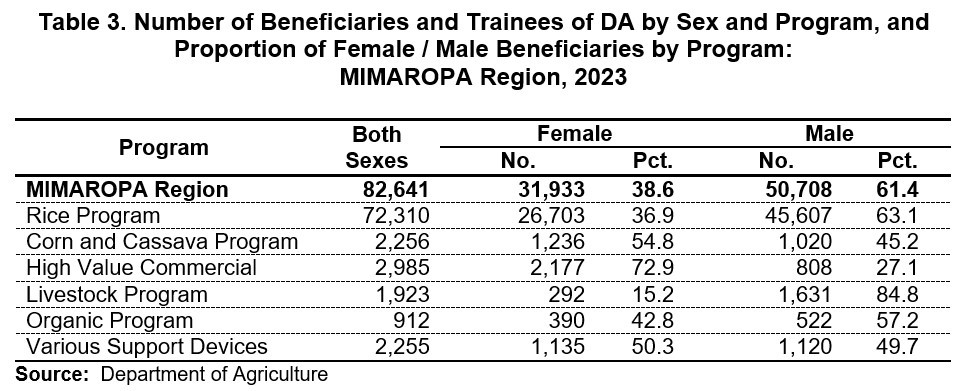
DA’s Rice Program had the largest chunk among its agricultural programs with a share of 87.5 percent. Women had 36.9 percent representation among the Rice Program beneficiaries. (Table 3)
The largest percentage of women beneficiaries and trainees were recorded for the High Value Commercial Program at 72.9 percent or 2,177 out of 2,985 beneficiaries. Other DA programs that are women-dominated are the Corn and Cassava Program (54.8%) and Various Support Devices (50.3%). (Table 3)
In contrast, DA’s Livestock Program had the least number of women beneficiaries and trainees at 292 out of the program’s 1,923 beneficiaries. The said program also had the least proportion of women beneficiaries among all DA programs. (Table 3)
More women completed their basic education studies than men
For school year 2022 to 2023, a larger percentage of women in the MIMAROPA Region completed their school year, according to Department of Education. Completion rate was recorded highest in elementary level at 98.6 percent. Women had the larger percentage of completion in elementary level at 99.3 compared to men with 97.6 percent. (Figure 3)
Moreover, in senior high school, women recorded a 77.6 percent completion higher than men at 72.8 percent. This level also showed the lowest completion rate at 75.6 percent. (Figure 3)
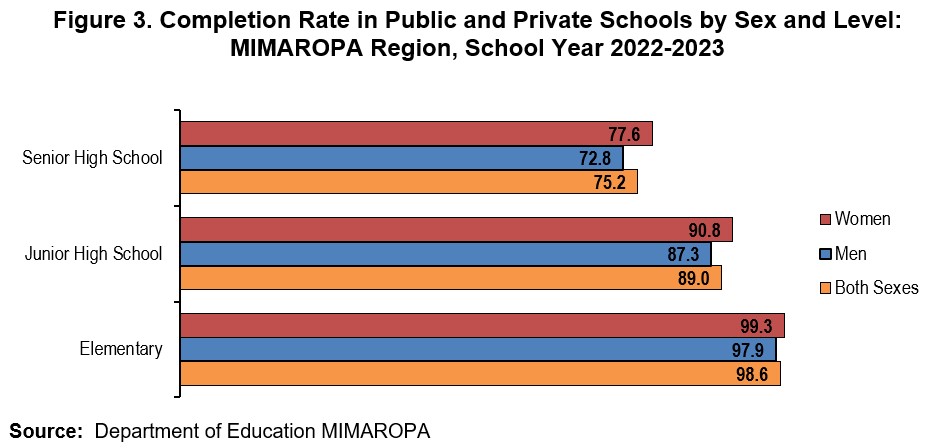
Largest percentage of women graduate under TVET program on garments
In the MIMAROPA Region, there were more men graduates of Technical and Vocational Education and Training (TVET) programs at 17,152 with a share of 56.2 percent of the total graduates. Men-dominated clusters were metal and engineering (1,962 male graduates, 86.5% share), construction (1,765 male graduates, 87.5% share), electronics (2,297 male graduates, 59.8% share), health, social and other communication (1,100 male graduates, 50.4% share), communication and information technology (607 male graduates, 59.6% share), and maritime (169 male graduates, 97.7% share). (Table 4)
Agriculture and Fishery cluster had the highest number of graduates in all TVET programs with 8,193 graduates. This cluster was women-dominated with 4,242 female graduates (51.8% share), while men totaled to 3,951 graduates (48.2% share). Moreover, the garments cluster had the largest percentage of female graduates, where 400 out of 461 graduates were women (86.8% share). Other TVET programs that are women-dominated include processed food and beverages (1,175 female graduates, 76.4% share), tourism (3,071 female graduates, 65.2% share), and garments were dominated by women. (Table 4)
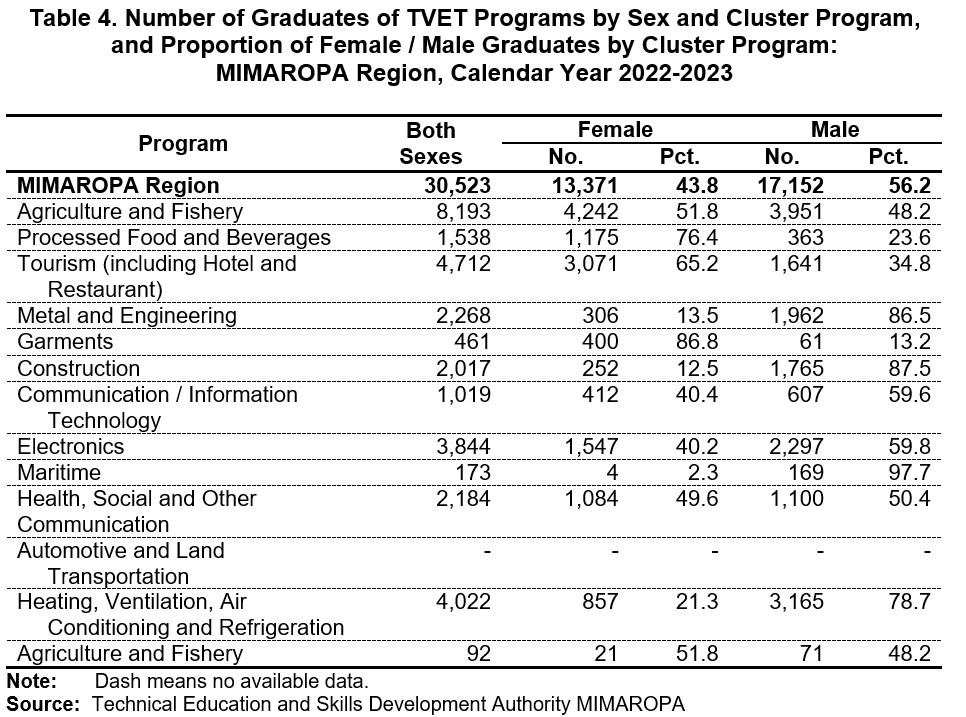
Women alumni outnumbered men in most major disciplines
There were 18,215 graduates of tertiary education in the MIMAROPA Region for the academic year 2022 to 2023. Of these, women accounted for the larger percentage share of 62.0 percent while men comprised the remaining 38.0 percent. (Figure 4)
Top three tertiary disciplines with women-dominated graduates during this academic year include medical and allied sciences (90.0%), humanities (76.3%), and education science and teacher training (75.4%). On the other hand, these three disciplines with men-dominated graduates include maritime (95.8%), engineering and technology (65.8%), and Information Technology (IT) related disciplines (50.9%). (Figure 4)
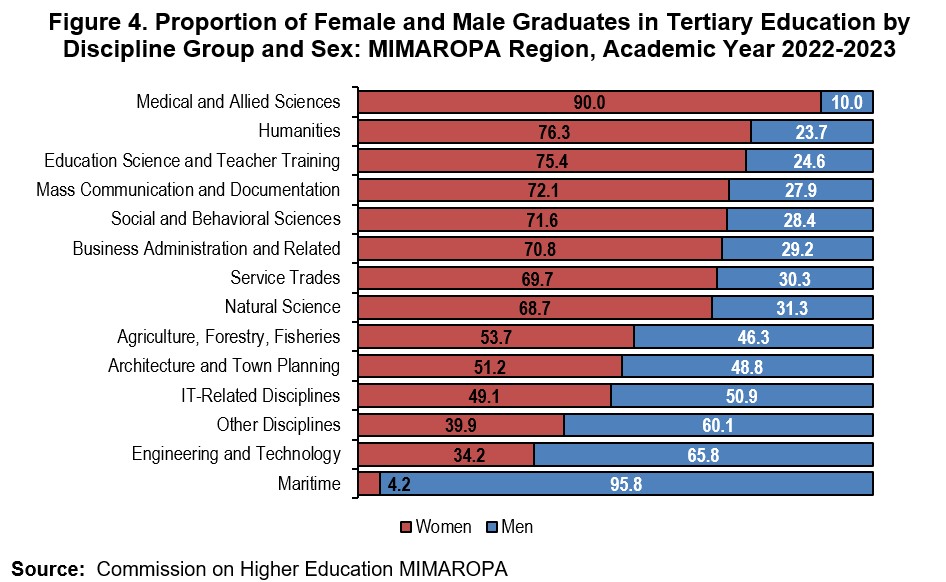
Women were infected the least from HIV
There were 312 recorded cases of Human Immunodeficiency Virus (HIV) infections in the MIMAROPA Region. Majority of these cases involved men, accounting to 94.6 percent while the remaining 16.7 percent were women. (Table 5)
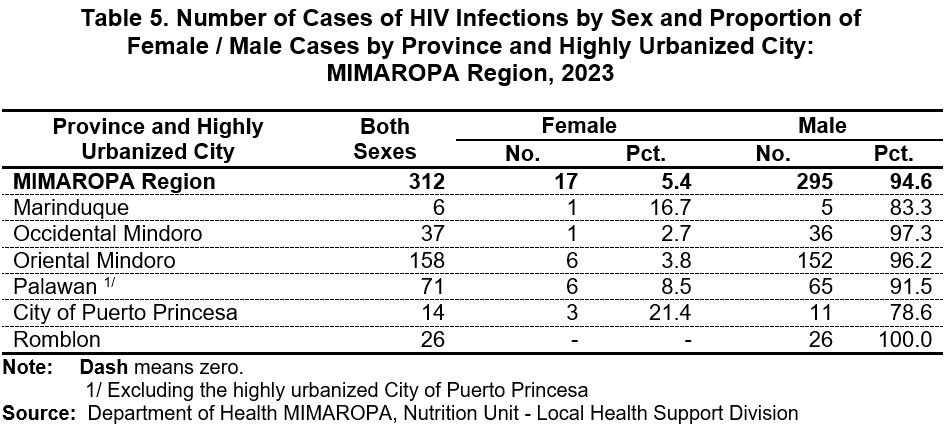
Moreover, the province of Oriental Mindoro showed the highest cases of HIV infections in the region, inclusive of cases from Calapan City which totaled to 158 cases or 50.6 percent of the individuals with HIV infection in the region. (Table 5)
Two-thirds of trafficked victims are women
According to the Department of Social Welfare and Development (DSWD) MIMAROPA, two out of three trafficked victims in MIMAROPA were women. A total of 27 cases of trafficking were reported in the region, 66.7 percent of these were women victims and 33.3 percent of the total victims were men. Among provinces, only Palawan (70.4%) and Occidental Mindoro (29.6%) had reported cases of trafficked victims. (Figure 5 and Table B)
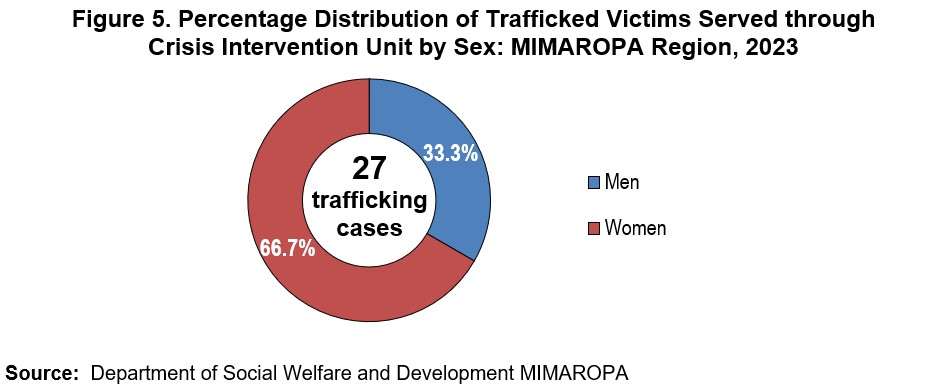
Nine of out ten children in need of special protection are women
In 2023, reported cases of children in need of special protection totaled to 226. Female children were the most vulnerable with 207 cases or 91.6 percent while the remaining 8.4 percent were male children. (Figure 6)
Among provinces in the region, Occidental Mindoro had the highest number of children in need of special protection with a total of 73 cases (32.3%). Of these, 67 were female children which accounted to 91.8 percent share. Meanwhile, only six (6) male children in the said province who are in need of special protection. It is worth noting that all provinces in the region showed a higher number of women in need of special protection. (Figure 6)
More than half of justice professionals are women
Under public life, a total of 121 justice professionals were recorded in the region. The number of government lawyer and judges almost equaled at 60 and 61, respectively. Additionally, women dominated the justice professionals at 53.7 percent or 65 in number. (Table C)
Among the government lawyers, 51.7 percent were women while 48.3 percent were men. On the other hand, majority of the judges or 55.7 percent were women while men accounted to 44.3 percent. (Figure 7)
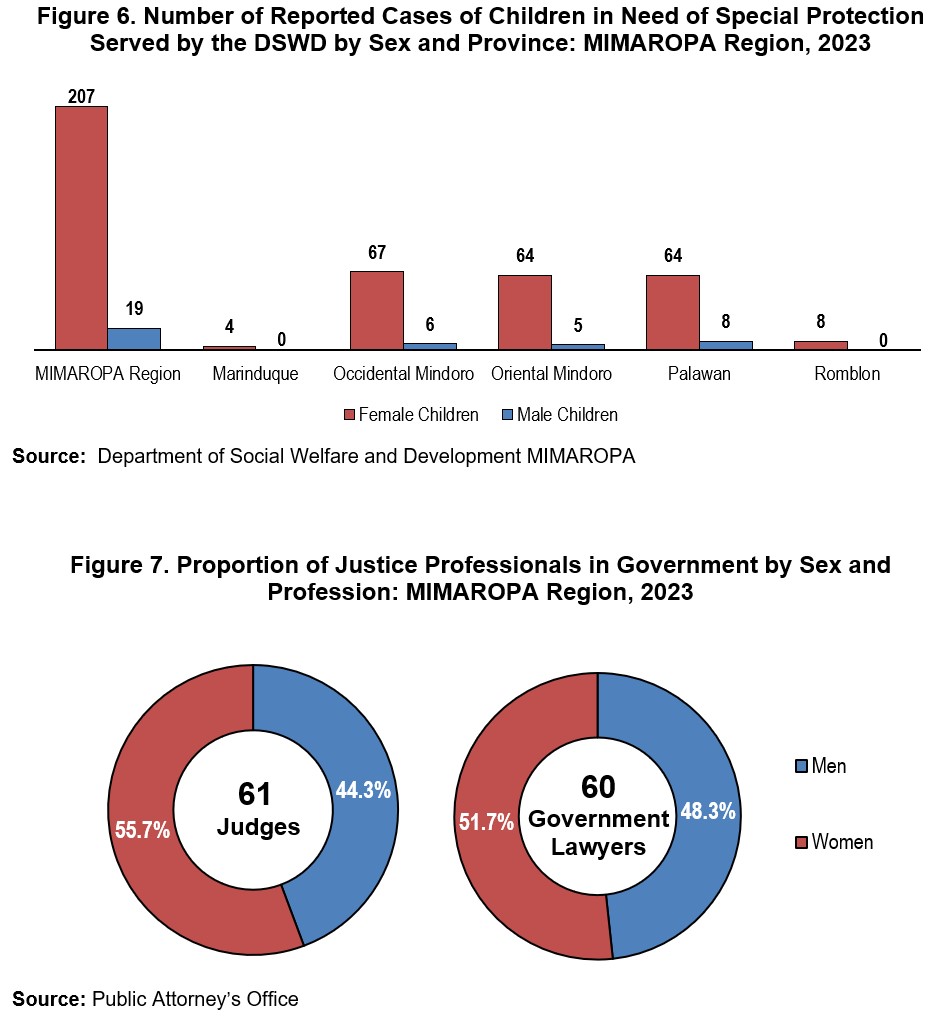
One in every four fire personnel is female
In the MIMAROPA Region, the number of fire personnel was recorded at 1,177 in 2023. Of this, 74.4 percent were men while women got the lower share of only 25.6 percent.(Table 6)
Among Field Offices of the Bureau of Fire and Protection MIMAROPA, the Field Office of Oriental Mindoro registered the highest number of 312 fire personnel (26.5%). On the other hand, the MIMAROPA Regional Office with 86 fire personnel (7.3%) got the lowest percentage share. (Table 6)
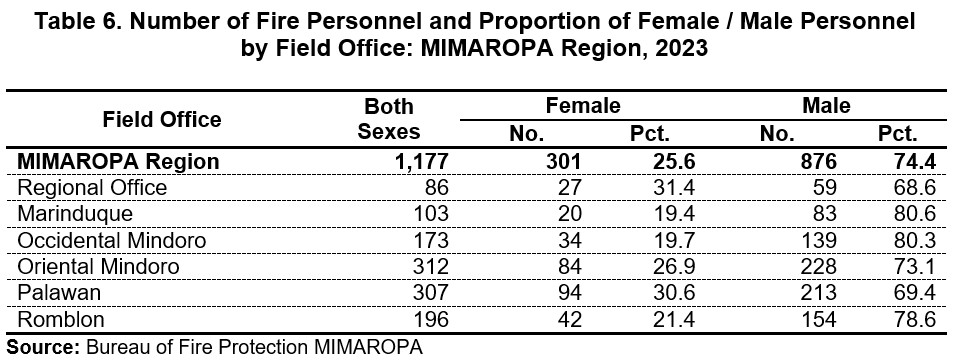
One in every 20 persons deprived of liberty is a woman
In 2023, the jail population in the MIMAROPA Region reached 2,022 persons deprived of liberty (PDLs). Of these, 96.2 percent were detained while the remaining 3.8 percent were already sentenced. Among these total number of PDLs, 97 were women with a corresponding 4.8 percent share to the regional jail population. Meanwhile, the remaining 95.2 percent of the jail population were male PDLs. (Table 7)

Among women PDLs, 87 were not yet sentenced in 2023. This constitutes 4.5 percent of the total PDLs classified as detained. Meanwhile, the remaining ten (10) women PDLs were sentenced and had 13.2 percent share to the total sentenced PDLs in the region. (Table 7)
Abuse mostly happens to female children
In 2023, a total of 1,087 abuse cases were reported in the MIMAROPA Region. Female children recorded the highest number of cases which accounted to 51.5 percent. This was followed by abuses against women at 37.7 percent. Moreover, more than one in every ten abuses or 10.7 percent occurred in male children. Among all provinces in the region, Oriental Mindoro got the highest number of reported abuse cases for women and children which accounted to 423 (38.9% share), and it was followed by Palawan which accounted to 240 reported cases (22.1% share). (Figure 8 and Table D)
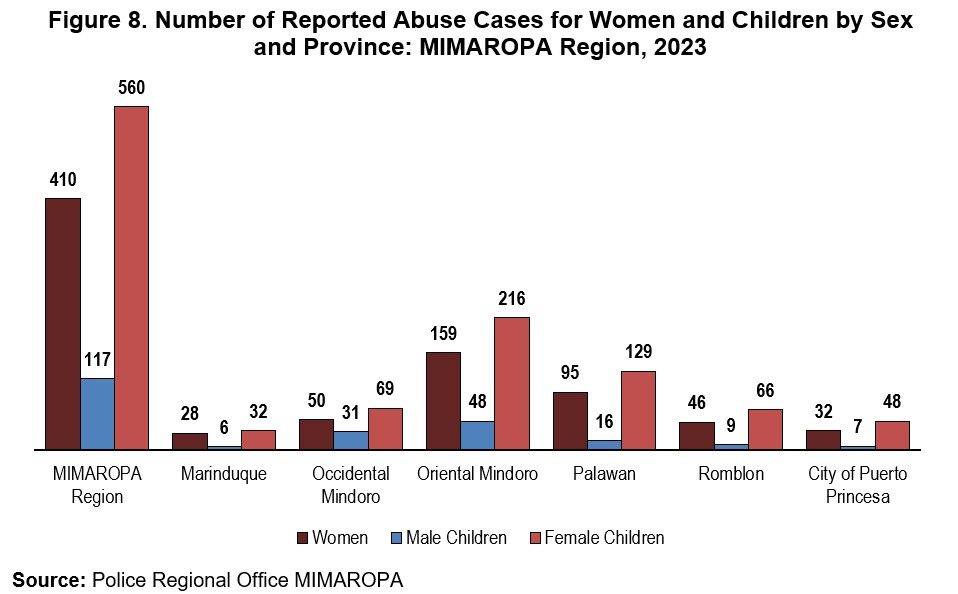
Almost half of regular patentees are women
The total number of regular patentees in the MIMAROPA Region were 1,605. Patent holders almost equaled with 763 men and 761 women. Among all types of regular patents issued, the regular patent for residential land had the largest number of 969 patentees with a corresponding 60.4 percent of the total number of issued regular patents. Of these, 49.7 percent were applied by and issued to women patentees. (Table 8)

Regular patent for agricultural lands posted the highest proportion of women patentees at 50.5 percent with a total of 274 patents issued. On the other hand, regular patent for special lands was the lowest recorded proportion of women patentees at 41.7 percent. (Table 8)
The statistics presented in this special release were based on the information provided by the Philippine Statistics Authority and various regional line agencies who provided statistical indicators as input to the eleven key chapters of the handbook – Population and Families, Work, Agriculture, Education, Health, Social Welfare, Public Life, Peace and Human Rights, Violence Against Women and Children, Environment, and Migration. Essential data were compiled in tables and charts with provincial and city level data to enhance local-level decision-making.
(SGD) LENI R. RIOFLORIDO
Regional Director
MLLM / RRL / MTYAD

